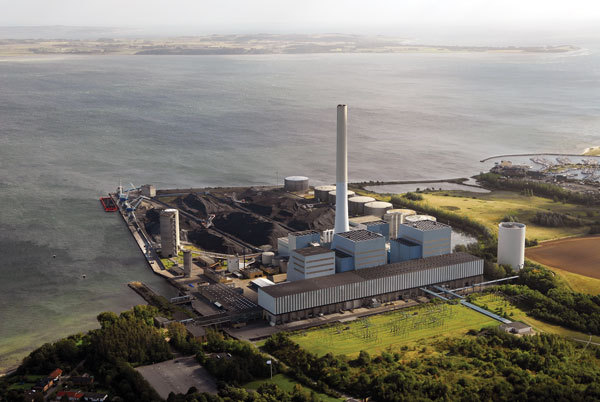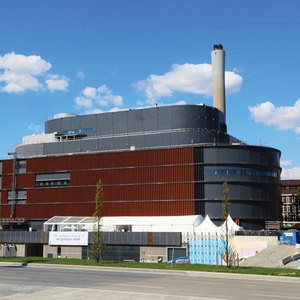Scandinavian Swap-Out







PHOTO: TIM PORTZ, BIOMASS MAGAZINE
November 30, 2016
BY Tim Portz
On May 9, the sun rose in Stockholm, Sweden, at 4:28 a.m., and wouldn’t set for well over 16 hours. Temperatures that day flirted with 80 degrees Fahrenheit, unseasonably warm weather. The guests on hand to witness the inauguration of the city’s new biomass-powered combined-heat-and-power (CHP) plant could be forgiven for having difficulty imagining a day when the city’s residents would need heat, and lots of it.
Reality, however, is that those warm spring and summer days in Stockholm eventually yield to fall and winter, and on the winter solstice, residents in the city will be just halfway through their afternoon when the sun sets at 2:48 p.m. The historical average daytime high on that day is 32 degrees F. It is then that Fortum Värme, jointly owned by the city of Stockholm and Fortum, a Finnish energy company, will be called upon to provide heat via a district energy system to nearly 200,000 homes in Stockholm.
In 2012, work began on the new facility, which is located at the site of the Värtaverket CHP plant, a coal-burning facility that had served the city since the late 1960s, when it was linked into the city’s growing district energy grid. Cost estimates for the construction of the facility approach €500 million ($543 million).
During the inauguration, Pekka Lundmark, Fortum CEO, addressed the biomass supply chain that will be relied on to deliver the 12,000 tons of feedstock the facility will require each day during its peak heating season. “Biomass is a renewable, largely local and carbon-neutral energy source,” he said. “Its use increases the share of domestic energy resources particularly in northern Europe, and it is an important building block of a sustainable energy system and the bioeconomy.”
The facility is positioned in the Hjorthagen neighborhood northeast of the city center, and, as is virtually all of the city, is situated near a busy waterway, teaming with cargo vessels, cruise ships and local passenger ferries. While this enviable proximity to the water would allow the facility to source biomass from all corners of the globe, the plant expects its imported biomass to be sourced largely from the nearby Baltics and Russia. A 200-meter pier was built to be able to simultaneously berth two biomass-carrying vessels at once, and early estimates suggest that about 60 percent of the biomass burned at the facility will utilize the new infrastructure. A crane with a discharge rate of 2,000 to 3,000 tons per hour has also been installed. The capacity at the pier should be more than enough to keep the plant well-stocked with fuel; remaining biomass will be received by rail at an indoor unloading facility to control fugitive dust. Plant officials expect to receive four or five shipments of wood chips via train weekly, with each delivering roughly 4,500 tons of chips.
Stolkholm’s transition from coal-derived heat and power to biomass fuel typifies a countrywide commitment to decarbonizing Sweden’s economy. The country already boasts one of Europe’s lowest per-capita greenhouse gas emission levels, and Fortum sees the new facility in Stockholm as a continuation of its decarbonization efforts. “After a long process, one of the world’s biggest biomass-fired combined-heat-and-power plants has now been inaugurated,” said Anders Egelrud, Fortum Värme managing director. “This is an important step towards a sustainable energy system in Stockholm and in Europe.”
Change of Season
On Oct. 10 in Aarhus, Denmark, the country’s second-largest city, DONG Energy celebrated a similar inauguration at the Studstrup Power Station, as the facility’s transition from coal to wood pellets was complete. “I’m delighted that we can now open the new, green Studstrup Power Station, which will be able to supply green district heating to Aarhus and green electricity to the Danish grid,” said Thomas Dalsgaard, DONG Energy executive vice president. “That means a significant contribution to the green revolution, and we’re well on the way to establishing an energy system that is green, independent and economically sustainable.”
The event marked the end of a two-year conversion process, and a new energy era for both DONG Energy and the city of Aarhus. Kristian Wurtz, alderman for the Department of Technology and Environment in Aarhus, sees the conversion not only as Denmark’s largest clean energy initiative, but perhaps more importantly, a vital component of the city’s climate ambitions. “Using wood pellets as fuel at Studstrup Power Station will mean a lot in terms of us achieving our climate targets,” he said. “It gives us the incentive to go further with the green transformation, something we intend to pursue to a greater degree together with residents and businesses.”
Once operating at full capacity, Studstrup will be capable of meeting the heating needs of over half of the city. Another facility, being built at nearby Lisbjerg, will contribute another 20 percent. “The conversion of Studstrup and the new facility at Lisbjerg means that we’ve taken a massive and important step towards fulfilling our ambition of becoming a CO2-neutral city by 2030,” Wurtz said.
For DONG, the conversion at Studstrup is just the first in a series of conversions intended to simultaneously increase the profits from district heating assets and reduce the carbon intensity of delivered energy. According to company data, in 2006, one kilowatt-hour (KWh) of energy generated 638 grams of CO2. By 2014, the company had driven that carbon intensity down to 374 grams, and is well on the way to its goal of 260 g CO2 per KWh by 2020.
Two more facilities, CHP plants at Avedore and Skaerbaek, are also tabbed for conversion to biomass inputs, and construction is underway. The company expects both facilities to be fully completed by the 2017-´18 heating season, dramatically increasing the percentage of biomass-derived heat in DONG’s portfolio. At the European Bioenergy Future conference in Brussels, Thomas Dalsgaard, executive vice president at DONG Energy, shared with attendees that DONG’s aggressive biomass conversion plans will eventually result in 1,400 MW of biomass-based power and 2,200 MW of biomass-derived heat. He told the audience that in 2020, the company intends to be producing over 60 percent of its delivered heat from biomass, an incredible growth plan considering that in 2009, just 14 percent of the company’s delivered heat came from biomass.
Collectively, these conversions across Scandinavia have firmly cemented biomass-derived heat and power as a viable pathway to the emissions reductions that so many local and national policymakers are seeking. Biomass conversions offer utilities and municipalities a plug-and-play option to bring existing district heating grids, electrical distribution networks, and shipping and receiving assets to bear on their climate goals, preserving those investments and recasting them as models of reinvention as Europe continues its aggressive push towards decarbonization.
Author: Tim Portz
Executive Editor, Biomass Magazine
tportz@bbiinternational.com
701-738-4969
Advertisement
Advertisement
Advertisement
Advertisement
Upcoming Events





